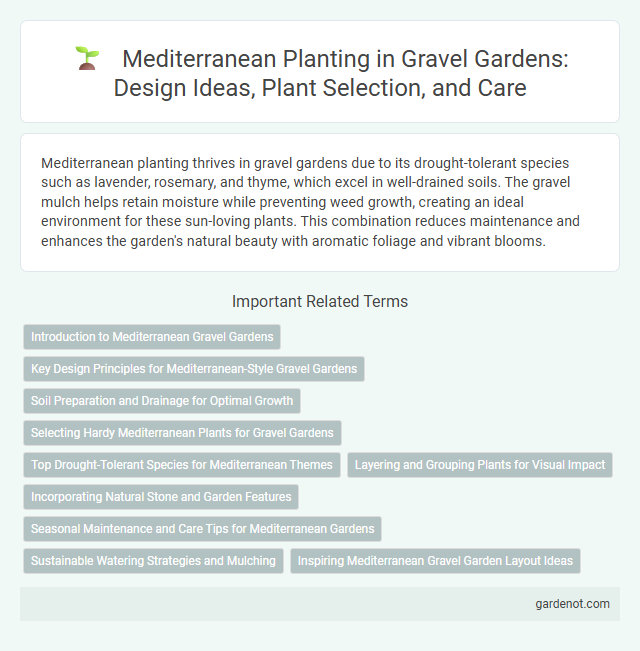Mediterranean planting thrives in gravel gardens due to its drought-tolerant species such as lavender, rosemary, and thyme, which excel in well-drained soils. The gravel mulch helps retain moisture while preventing weed growth, creating an ideal environment for these sun-loving plants. This combination reduces maintenance and enhances the garden's natural beauty with aromatic foliage and vibrant blooms.
Introduction to Mediterranean Gravel Gardens
Mediterranean gravel gardens feature drought-tolerant plants such as lavender, rosemary, and thyme, thriving in well-drained, rocky soils under intense sunlight. These gardens emphasize sustainable landscaping by minimizing water use and promoting native species adapted to hot, dry climates. Incorporating gravel mulch improves soil moisture retention and suppresses weeds while enhancing the garden's aesthetic with natural textures and colors.
Key Design Principles for Mediterranean-Style Gravel Gardens
Mediterranean-style gravel gardens emphasize drought-tolerant plants such as lavender, rosemary, and olive trees, thriving in well-drained, nutrient-poor soils typical of gravel beds. Key design principles include selecting native or adapted species that require minimal water, arranging plants to create textural contrasts and seasonal interest, and incorporating architectural elements like terracotta pots or stone benches to evoke a rustic, sun-drenched ambiance. Optimizing irrigation with drip systems and using light-colored, reflective gravel enhances moisture retention and temperature regulation, ensuring a sustainable yet visually striking garden.
Soil Preparation and Drainage for Optimal Growth
Mediterranean planting in gravel gardens thrives on well-prepared, nutrient-rich soil with excellent drainage to prevent waterlogging and root rot. Incorporate coarse sand or grit into the soil to enhance permeability and ensure excess water drains quickly. Elevate planting beds and use porous materials to maintain the dry, airy conditions essential for drought-tolerant Mediterranean species.
Selecting Hardy Mediterranean Plants for Gravel Gardens
Selecting hardy Mediterranean plants for gravel gardens involves choosing drought-tolerant species such as lavender, rosemary, and oregano, which thrive in well-drained, alkaline soils typical of these settings. Succulents like sedum and sempervivum add texture and require minimal water, complementing the rugged aesthetic of gravel gardens. Incorporating evergreen shrubs such as oleander and cistus ensures year-round structure and resilience against Mediterranean climate extremes.
Top Drought-Tolerant Species for Mediterranean Themes
Mediterranean gravel gardens thrive with drought-tolerant species such as lavender (Lavandula angustifolia), rosemary (Rosmarinus officinalis), and oleander (Nerium oleander), all of which require minimal water and flourish in well-drained soils. These plants offer hardy textures and aromatic foliage, enhancing the garden's resilience and aesthetic appeal. Incorporating drought-resistant grasses like Stipa tenuissima and succulents like Sedum further optimizes water conservation while supporting Mediterranean garden themes.
Layering and Grouping Plants for Visual Impact
Layering and grouping Mediterranean plants in a gravel garden enhances visual impact by combining varied textures and heights, such as tall lavender with low-growing rosemary and trailing thyme. Strategic placement of drought-tolerant species like olive trees and agave creates depth while maximizing water efficiency. This approach not only mimics natural Mediterranean landscapes but also promotes biodiversity and year-round interest.
Incorporating Natural Stone and Garden Features
Mediterranean planting in a gravel garden thrives when natural stone elements such as limestone, sandstone, and terracotta are integrated to mimic the region's rugged terrain and enhance soil drainage. Incorporating garden features like low stone walls, rustic benches, and stone pathways not only adds texture and structure but also supports drought-tolerant plants like lavender, rosemary, and olive trees. These natural stone components help retain heat, creating a microclimate ideal for Mediterranean flora while contributing to a sustainable and visually striking landscape design.
Seasonal Maintenance and Care Tips for Mediterranean Gardens
Seasonal maintenance in Mediterranean gravel gardens involves regular pruning of drought-tolerant shrubs like lavender and rosemary to encourage healthy growth and prevent woody stems. Consistent monitoring of irrigation is crucial, ensuring deep but infrequent watering to mimic natural dry spells and promote root resilience. Removing fallen leaves and debris maintains soil aeration and reduces fungal risks, preserving the garden's aesthetic and health throughout the year.
Sustainable Watering Strategies and Mulching
Mediterranean planting in gravel gardens thrives with sustainable watering strategies that emphasize deep, infrequent watering to promote drought resilience in native plants like lavender and rosemary. Mulching with organic materials such as wood chips or gravel not only conserves soil moisture but also suppresses weeds and regulates soil temperature. Implementing these techniques reduces water usage by up to 50%, supporting eco-friendly gardening in arid climates.
Inspiring Mediterranean Gravel Garden Layout Ideas
Mediterranean gravel gardens thrive with drought-tolerant plants like lavender, rosemary, and olive trees, creating a natural and low-maintenance landscape ideal for sunny, dry climates. Incorporating terracotta pots, aged stone pathways, and gravel beds enhances drainage and accentuates the rustic charm of the Mediterranean aesthetic. Strategic layering of aromatic herbs alongside drought-resistant succulents maximizes texture and fragrance, fostering an inviting and sustainable outdoor space.
Mediterranean planting Infographic

 gardenot.com
gardenot.com